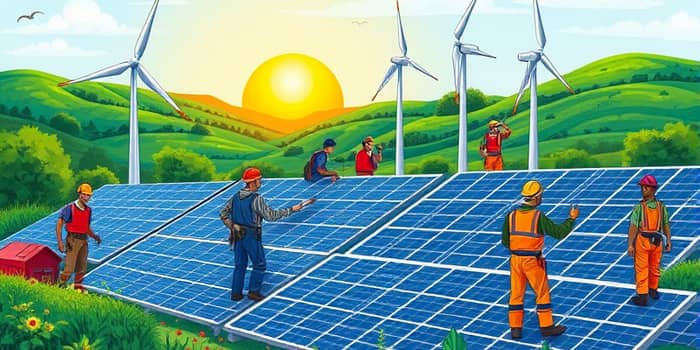
Green energy investments have emerged as a transformative force shaping modern economies and labor markets around the world. As governments and businesses commit to ambitious climate targets, the pace of renewable energy adoption accelerates, giving rise to opportunities unlike any seen in previous industrial revolutions. From the rooftops of suburban homes covered in solar panels to offshore wind farms harnessing ocean breezes, the landscape of work is changing before our eyes. This article explores how strategic clean energy deployment strategies are fueling unprecedented growth and equipping communities for a sustainable tomorrow.
Over the past decade, the renewable energy sector has undergone a remarkable expansion, driven by rapid technological improvements and supportive policy frameworks. Employment in this field is projected to rise by 8% in 2024, climb to 9% in 2025, and surge by an astonishing 40% by the end of the decade. These projections reflect an ecosystem where innovation and investment intersect, creating unprecedented opportunities for skilled workers and stimulating regional economic renewal.
Government incentives such as tax credits, subsidies, and favorable regulations have encouraged private capital to flow into solar, wind, and emerging technologies like green hydrogen. Moreover, public awareness of climate risks has sparked consumer demand for cleaner electricity, further amplifying job creation. As global energy markets evolve, stakeholders must monitor trends carefully to align workforce development with industry needs.
The renewable energy sector is on track to add nearly 10 million jobs worldwide by 2030. Solar energy alone is expected to account for roughly 75% of these positions, while wind power will contribute an additional 15%. By 2023, the sector employed 16.2 million people—a rise of 18% compared to the previous year—underscoring the momentum behind this green wave. These figures illustrate the global demand for green energy skills and the scale of opportunity awaiting job seekers.
While China leads the pack, emerging markets in Asia, Africa, and Latin America are swiftly ramping up capacity. This geographic shift underscores the need for targeted training programs and international partnerships to ensure that local populations can seize these new roles.
Innovation lies at the heart of the renewable revolution. Breakthroughs in solar photovoltaic manufacturing have greatly reduced the cost per watt of installed capacity, making solar installations more accessible than ever. Meanwhile, advanced wind turbine designs deliver higher efficiency and stability, unlocking offshore and high-altitude wind potential. Together, these developments are reshaping the global electricity mix and creating specialized roles in research and development.
Battery energy storage and hydrogen technology are particularly transformative, as they address intermittency challenges and enable round-the-clock clean power. As utilities and grid operators integrate these solutions, demand grows for technicians, engineers, and project managers with expertise in energy systems and digital grid controls.
The rapid expansion of green energy has brought a new set of challenges and rewards to labor markets. Employers face a widening skills gap in emerging clean technologies, leading to competitive salaries and robust benefits packages. In 2025 alone, 48% of renewable energy professionals reported a pay increase, with 21% receiving rises of 5% or more. This trend highlights the premium placed on expertise in clean power installations and systems integration.
Another notable shift is the rise of cross-regional mobility. As companies pursue projects around the globe, they are offering relocation and remote-work options to attract top talent. For workers, this translates into cross-regional mobility and flexibility, enabling them to build international careers and share best practices across markets.
The National Renewable Energy Laboratory (NREL) provides comprehensive projections that highlight state-by-state growth in solar, wind, battery storage, and energy efficiency roles. For example, Sun Belt states anticipate double-digit percentage gains in solar installer positions, while coastal regions foresee substantial increases in offshore wind engineering jobs. Local governments are leveraging these insights to tailor workforce development initiatives, ensuring that training programs align with projected demand.
By collaborating with community colleges, vocational schools, and private training providers, policymakers can bridge the gap between academic credentials and real-world requirements. This proactive approach bolsters economic resilience and positions regions to attract further clean energy investment.
Beyond economic rewards, renewable energy projects deliver substantial social and environmental co-benefits. Communities near solar farms and wind parks experience improved air quality, fewer health issues, and new educational opportunities through partnerships with research institutions. Together, these factors underscore the pivotal role in job creation that clean power plays in modern society.
The trajectory of green energy investments is clear: continued growth, technological breakthroughs, and widespread job creation. As solar, wind, battery storage, and hydrogen technologies mature, they will generate millions of positions that span engineering, manufacturing, installation, and maintenance. To harness this wave of opportunity, individuals should prioritize upskilling in digital energy management, grid integration, and sustainability planning.
Governments, industry leaders, and educators must collaborate to cultivate talent pipelines that match evolving skill requirements. By embracing a holistic strategy—combining policy incentives, targeted training, and community engagement—we can ensure that the transition to clean energy not only mitigates climate risks but also drives equitable economic and social progress.
In this era of transformation, green energy investments represent more than infrastructure upgrades; they embody a collective commitment to a cleaner planet and a thriving global workforce. Join this dynamic movement today and become part of the solution powering our sustainable future.
References













